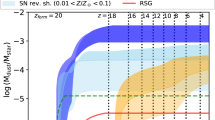Abstract
Results of modeling the chemical evolution of protostellar objects are presented. The models take into account the existence of different dust populations with distinct grain sizes, total mass fractions, and temperatures. In addition to ”classical” dust grains, the models include an entirely different second dust population, with dust grain sizes of 30 Å and a higher temperature. Two chemical-evolution models are compared, one taking into account only classical dust and the other including both dust populations. The influence of a complex dust composition on the general evolution of the molecular contents of prestellar cores and the abundances of a number of chemical species is studied. At early evolutionary stages, differences are mainly determined by the modification changes in the photoprocesses’ balance due to efficient UV absorption by the second population of dust grains and in collisional reactions with the dust grains. At late stages, distinctions between the models are also determined by the increasing dominance of additional reaction channels. The species that respond to the presence of small grains in different ways are separated into different groups. Allowing for the presence of small grains makes it possible to significantly lower the water abundance in the gas phase.
Similar content being viewed by others
References
E. Krügel, The Physics of Interstellar Dust (IOP Publ., Bristol, Philadelphia, 2003).
R. Visser, E. F. van Dishoeck, S. D. Doty, and C. P. Dullemond, Astron. Astrophys. 881, 495 (2009).
A. I. Vasyunin, D. A. Semenov, D. S. Wiebe, and Th. Henning, Astrophys. J. 1459, 691 (2009).
E. Herbst and V. I. Shematovich, Astrophys. Space Sci. 285, 725 (2003).
T. I. Hasegawa, E. Herbst, and Ch. M. Leung, Astrophys. J. Suppl. Ser. 167, 82 (1992).
J. S. Mathis, W. Rumpl, and K. H. Nordsieck, Astrophys. J. 425, 217 (1977).
J. C. Weingartner and B. T. Draine, Astrophys. J. 296, 548 (2001).
A. I. Vasyunin, D. S. Wiebe, T. Birnstiel, S. Zhukovska, Th. Henning, and C. P. Dullemond, Astrophys. J. 17, 727 (2011).
V. Akimkin, S. Zhukovska, D. Wiebe, D. Semenov, Ya. Pavlyuchenkov, A. Vasyunin, T. Birnstiel, and Th. Henning, Astrophys. J. 24, 766 (2013).
K. Acharyya, G. E. Hassel, and E. Herbst, Astrophys. J. 15, 732 (2011).
Ya. N. Pavlyuchenkov, D. S. Wiebe, V. V. Akimkin, M. S. Khramtsova, and Th. Henning, Mon. Not. R. Astron. Soc. 2430, 421 (2012).
O. V. Kochina, D. S. Wiebe, S. V. Kalenskii, and A. I. Vasyunin, Astron. Zh. 91, 90 (2014).
B. T. Draine and H. M. Lee, Astrophys. J. 89, 285 (1984).
J. Woodall, M. Agundez, A. J. Markwick-Kemper, and T. J. Millar, Astron. Astrophys. 466, 1197 (2007).
T. I. Hasegawa and E. Herbst, Mon. Not. R. Astron. Soc. 261, 83 (1993).
E. A. Bergin, M. R. Hogerheijde, C. Brinch, J. Fogel, U. A. Yildiz, L. E. Kristensen, E. F. van Dishoeck, T. A. Bell, G. A. Blake, J. Cernicharo, C. Dominik, D. Lis, G. Melnick, D. Neufeld, O. Panic, J. C. Pearson, R. Bachiller, A. Baudry, M. Benedettini, A. O. Benz, P. Bjerkeli, S. Bontemps, J. Braine, S. Bruderer, P. Caselli, C. Codella, F. Daniel, A. M. di Giorgio, S. D. Doty, P. Encrenaz, M. Fich, A. Fuente, T. Giannini, J. R. Goicoechea, Th. de Graauw, F. Helmich, G. J. Herczeg, F. Herpin, T. Jacq, D. Johnstone, J. K. Jorgensen, B. Larsson, R. Liseau, M. Marseille, C. McCoey, B. Nisini, M. Olberg, B. Parise, R. Plume, C. Risacher, J. Santiago-Garcia, P. Saraceno, R. Shipman, M. Tafalla, T. A. van Kempen, R. Visser, S. F. Wampfler, F. Wyrowski, F. van der Tak, W. Jellema, A. G. G. M. Tielens, P. Hartogh, J. Stutzki, and R. Szczerba, Astron. Astrophys. 521, L33 (2010).
Author information
Authors and Affiliations
Corresponding author
Additional information
Original Russian Text © O.V. Kochina, D.S. Wiebe, 2014, published in Astronomicheskii Zhurnal, 2014, Vol. 91, No. 4, pp. 287–298.
Rights and permissions
About this article
Cite this article
Kochina, O.V., Wiebe, D.S. Different-sized dust grains and the chemical evolution of protostellar objects. Astron. Rep. 58, 228–239 (2014). https://doi.org/10.1134/S1063772914040064
Received:
Accepted:
Published:
Issue Date:
DOI: https://doi.org/10.1134/S1063772914040064




